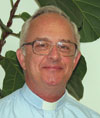
Editorial
Symbols and artisans of the Reign of God
By Fr. Mike Traher, S.F.M.
December 2007
Return to Table of Contents
Print Article
Auxiliary Bishop of Halifax, Claude Champagne, last August addressed the 2007 Plenary Assembly of the Canadian bishops on the topic of the "New Evangelization: New challenges for the Church's mission in Canada." He began by affirming that "the primary mission, the most important in our world today, is first and foremost that of the Spirit of the Risen Christ, already at work, who precedes us in the world."
The second most important element for the "new evangelization" he added is "the central role of the Reign of God as proclaimed and inaugurated by Jesus in his Paschal Mystery." Bishop Champagne said that in recent decades as a Church we have understood that this proclamation and inauguration of God's Reign is the goal of Jesus. And we as members of the Church are called to be symbols and artisans in the service of the Reign of God.
Bishop Champagne's presentation on mission represents a change in the Church's traditional focus for mission. Rather than to increase its membership, the focus now includes a much wider and inclusive vision of the Reign of God. It is in this broader vision of mission that we as Scarboro missioners find ourselves today, especially as reflected in the variety of thoughts and experiences shared by our priests and laity in this Christmas vocational issue.
To be in mission is to respond to the Spirit of the Risen Christ alive and at work among the peoples, cultures and religious traditions wherever we are. As Scarboro missioners we have found ourselves invited to "come and see," come and live, and come and serve beyond our borders in what is truly a creative and exciting vocation.
As much as we have witnessed the liberating and healing power of God among the people we have served overseas, many of us while in mission have also been profoundly changed by God. This becomes especially evident when we come together as we did for our General Chapter this past June. As soon as we got together, we began quickly trading stories of mission. These were stories about our minds and hearts being transformed in ways that we can only attribute to the Spirit of God acting within us and through the people where we are present in mission.
In this new millennium, post 9/11, we recognize that new challenges await the missionary who sets forth in fresh witness to God's love for the world. Bishop Champagne names some of these new challenges as sustainable development, preservation of the environment, justice and peace, and the meeting of world religions. At our General Chapter in June, Scarboro delegates reaffirmed these same priorities to guide our Society in mission over the next five years.
Today's missionary may be developing new communities of faith for the future, serving older communities in need, or respectfully entering the lives and cultures of other people in a variety of new ways of service and presence. Whether priest, religious or lay, the missioner recognizes that we are responding to the call of the Spirit of the Risen Christ.
Whatever the context for new ways of being in mission, we are also conscious that the Spirit is calling all who share this mission to be faith-filled, joyful and authentic witnesses, people of dialogue, people of action and contemplation who can evangelize and be evangelized in the process of living out their mission.
Ultimately our vocation as "symbols and artisans" of the Reign of God is to give a humble witness to a personal God who out of love and no other motivation was born one like us, who lived and died for the salvation of all the world. As co-workers guided by the Spirit of the Risen Christ, we are mandated to creatively and attentively invite the world to take part in the greatest Divine Project, the ultimate destiny offered to all people and for the whole of creation: to belong forever to the Reign of God.
Fr. Mike Traher is in leadership as Vicar General on Scarboro's General Council.
Return to Table of Contents
Print Article